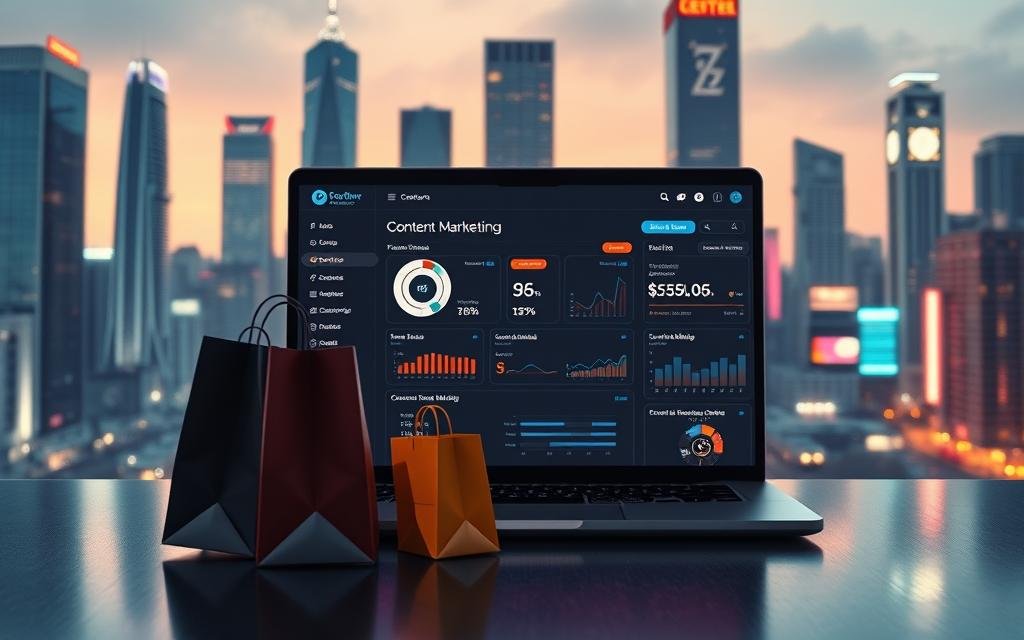In today’s online world, a good search engine optimization plan is key for ecommerce sites to thrive.
A solid strategy can boost your site’s rankings, bring in more visitors, and lead to more sales.
With the right seo strategies, ecommerce sites can get more seen online, attract more people, and keep up with rivals.
To succeed online, you need to know how search engines work and how to make your site better for them.
Key Takeaways
- Improve website rankings with effective search engine optimization
- Drive organic traffic and increase conversions
- Enhance online visibility and reach a wider audience
- Stay ahead of the competition with a well-planned SEO approach
- Understand how search engines work and optimize according
Understanding E-Commerce SEO Fundamentals
Learning about e-commerce SEO is key for online stores wanting to be seen more online. It’s different from other SEO because of its own set of challenges and chances.

What Makes E-Commerce SEO Different
E-commerce sites have lots of product pages, making keyword research and optimization harder. They also have a special structure with categories and subcategories. This needs a good SEO strategy.
As Moz says, “E-commerce SEO is about knowing the customer’s journey and making your site meet their needs at every step.” It’s not just about product pages. It’s also about making sure users have a good experience.
Key Ranking Factors for Online Stores
There are several important factors for e-commerce SEO success. These include:
- Page speed: A fast website is better for users and search engines.
- Mobile-friendliness: Most shoppers use mobile, so your site needs to work well on it.
- Content quality: Good, relevant content keeps customers coming back.
- User experience: A well-designed site makes shopping easier and boosts sales.
| Ranking Factor | Importance | Impact on SEO |
|---|---|---|
| Page Speed | High | Improves user experience and search engine rankings |
| Mobile-Friendliness | High | Essential for user experience and search engine rankings |
| Content Quality | High | Attracts and retains customers, improving conversion rates |
Setting Up Your SEO Foundation
To build a strong SEO base, online stores need to do deep keyword research. This means finding the right terms and phrases for their products. It’s about knowing what customers are looking for and making sure your site meets their needs.
“The key to successful e-commerce SEO is understanding your customer’s search behavior and optimizing your site to meet their needs.”
On-page optimization is also key. This includes things like meta tags, header tags, and product descriptions. Making sure each product page is set up for the right keywords can really help your site rank better.
Essential Technical SEO Elements for E-Commerce Success
In the world of e-commerce, technical SEO is key to your website’s ranking. A well-optimized site boosts user experience and visibility online.
Technical SEO includes page speed, mobile-friendliness, and website security. These are vital for search engines to crawl, index, and rank your site well.
Page speed is crucial. A slow site can cause high bounce rates and low conversion rates. To speed up, compress images, use browser caching, and reduce CSS and JavaScript files.

Mobile-friendliness is also key. Most online shoppers use mobiles. A responsive design that fits all screen sizes is essential. Make sure your site’s layout, content, and navigation work well on mobiles.
Website security is vital too. Google favors secure sites (HTTPS) over non-secure ones (HTTP). To secure your site, get an SSL certificate and use HTTPS for all pages.
| Technical SEO Element | Importance | Optimization Tips |
|---|---|---|
| Page Speed | High | Compress images, leverage browser caching, minimize CSS and JavaScript |
| Mobile-Friendliness | High | Responsive design, mobile-friendly layout and navigation |
| Website Security | High | Obtain SSL certificate, serve pages over HTTPS |
By focusing on these technical SEO elements, e-commerce sites can boost rankings, drive more traffic, and increase sales. Regularly check and improve these areas to stay ahead in e-commerce.
Mastering Product Page Optimization
To stand out in the competitive e-commerce world, mastering product page optimization is key. A well-optimized product page boosts your online store’s visibility. It drives more sales and improves customer satisfaction.
Writing Compelling Product Descriptions
Product descriptions are vital for content optimization. They should be detailed, engaging, and informative. This helps customers make informed purchasing decisions. Use clear and concise language to highlight your products’ benefits and features.
Here are some tips for writing compelling product descriptions:
- Focus on the benefits of the product, not just its features.
- Use sensory language to help customers imagine using the product.
- Incorporate relevant keywords naturally to improve SEO.
- Ensure descriptions are unique and not duplicated across products or copied from manufacturers.
Optimizing Product Images
Product images are as important as product descriptions. High-quality images enhance the customer’s shopping experience. To optimize product images, consider the following:
- Use high-resolution images that showcase the product from different angles.
- Optimize image file names and alt tags with relevant keywords.
- Compress images to reduce file size and improve page load times.

Implementing Schema Markup
Schema markup is a powerful tool for enhancing your product pages’ visibility in search engine results. By adding schema markup to your product pages, you can provide search engines with additional context about your products, such as reviews, prices, and availability.
| Schema Type | Description | Benefits |
|---|---|---|
| Product Schema | Provides detailed information about a product, including name, description, and image. | Enhances search engine results with rich snippets, improving click-through rates. |
| Review Schema | Highlights customer reviews and ratings for products. | Builds trust with potential customers by showcasing social proof. |
Managing Customer Reviews
Customer reviews are a crucial aspect of product page optimization. They not only provide social proof but also contribute to improving your page’s SEO. Encourage customers to leave reviews by making the process as simple as possible.
Here are some strategies for managing customer reviews effectively:
- Respond promptly to all reviews, both positive and negative.
- Use review data to identify areas for product improvement.
- Display reviews prominently on product pages to build trust with potential customers.
Creating an Effective E-Commerce Site Structure
A well-organized site structure is key for e-commerce sites. It boosts user experience and search engine rankings. A good site structure makes it easy for users and search engines to find what they need.
This leads to better engagement and higher conversion rates.
To achieve this, consider the following key elements:
- Clear Navigation: Make sure your website’s navigation is easy to use. This lets users find products without hassle.
- Easy-to-Use Interfaces: Use interfaces that are friendly and work well on all devices.
- Well-Organized Site Hierarchy: Organize your site in a logical way. This means categorizing products and subcategories well.
An effective site structure also makes your website easier for search engines to crawl. This means they can index your pages better. This can help you show up more in search results.

- Limiting the number of categories and subcategories to avoid complexity.
- Using descriptive and concise URLs for product and category pages.
- Implementing breadcrumb navigation to help users understand their location within your site.
By focusing on these aspects, you can make an e-commerce site structure that improves user experience. It also supports your SEO efforts. This can drive more conversions and sales.
Advanced SEO Strategies for Online Retail
The digital world is always changing, and online stores need to keep up. Just having a website isn’t enough anymore. They must use smart SEO tactics to rank higher and attract more visitors.
Voice Search Optimization
Voice assistants like Siri and Google Assistant are changing how we search online. Voice search optimization is key for online shops. They should use natural language and long-tail keywords that sound like how we talk.
- Use conversational keywords and phrases
- Optimize product descriptions for voice search queries
- Ensure your website is mobile-friendly
Mobile-First Indexing
Most searches now happen on mobile devices. Mobile-first indexing is vital for e-commerce SEO. Google favors mobile sites when indexing and ranking. Make sure your site is responsive, loads fast, and works well on all devices.
| Aspect | Desktop | Mobile |
|---|---|---|
| Loading Speed | 3 seconds | 2 seconds |
| User Experience | Complex Navigation | Simple, Intuitive |
| Content | Detailed Product Info | Concise, Scannable |
Local SEO for E-Commerce
For online stores with physical locations or serving specific areas, local SEO is essential. It means making your site rank better in local searches. Claim and optimize your Google My Business listing, use local keywords, and create content for your local audience.

By using these advanced SEO strategies, online stores can boost their visibility, attract more targeted traffic, and increase sales. Keeping up with the latest SEO trends is crucial for success in the competitive e-commerce world.
Keyword Research for E-Commerce Success
Keyword research is key for e-commerce SEO. It’s not just about finding popular search terms. It’s about knowing what your customers want and how to meet their needs.
Finding High-Converting Keywords
Finding the right keywords is essential for e-commerce success. It’s not just about getting lots of traffic. It’s about getting the right traffic that buys.
Tools like Google Keyword Planner, Ahrefs, and SEMrush help find these keywords. They look for keywords that have a good chance of converting.
Understanding Search Intent
Knowing what users are looking for is crucial. Are they buying, learning, or looking for a specific site? By matching your content to their needs, you can improve their experience and boost sales.
Competitor Keyword Analysis
Looking at your competitors’ keywords can reveal a lot. Tools like Ahrefs and SEMrush show what keywords your competitors use. This helps you find ways to beat them.
| Tool | Key Features | Pricing |
|---|---|---|
| Google Keyword Planner | Keyword suggestions, traffic estimates | Free |
| Ahrefs | Comprehensive keyword database, competitor analysis | $99-$999/month |
| SEMrush | Keyword research, competitor analysis, technical SEO audit | $99.95-$449.95/month |

By focusing on keyword research, understanding search intent, and analyzing competitors, e-commerce can boost its SEO. This leads to more traffic and sales.
Content Marketing Strategies for E-Commerce
In the world of e-commerce, content marketing strategies are key to boosting sales and visibility. High-quality, engaging content grabs potential customers’ attention. It sets your brand apart from others.
To succeed in e-commerce content marketing, know your audience well. Create content that meets their needs and interests. This could be product reviews, tutorials, blog posts, or social media content that enriches their shopping journey.

For a winning content marketing plan, e-commerce sites should focus on a few important points:
- Know what customers want and make content that answers their questions.
- Use different content types like videos, infographics, and blog posts.
- Make sure content is easy to find online to boost visibility.
- Reuse content to get more out of it and increase its value.
A solid content marketing strategy boosts customer interaction and SEO rankings. By prioritizing quality over quantity, e-commerce sites can earn customer trust. This leads to more sales over time.
| Content Type | Purpose | Benefits |
|---|---|---|
| Product Reviews | Build trust and credibility | Increased customer confidence, improved conversion rates |
| Blog Posts | Educate and inform | Establishes brand authority, improves SEO |
| Social Media Content | Engage and interact | Enhanced brand visibility, improved customer engagement |
By using these content marketing strategies, e-commerce sites can build a strong online presence. This attracts and keeps customers, helping the business grow.
Link Building Techniques for Online Stores
Link building is key for e-commerce sites to rank better in search engines and boost sales. A good link building plan can make your online store more visible and trustworthy. It also improves your SEO.
Building Quality Backlinks
Getting quality backlinks is a must for link building. It means getting links from sites that are known and related to your e-commerce site. Guest blogging is a smart way to get these backlinks. By writing great content for other sites, you earn backlinks that boost your site’s trustworthiness.
To get quality backlinks, make sure your content is top-notch. This could be detailed guides, original research, or unique product descriptions. Other sites will want to link to this.
Internal Linking Strategy
An internal linking strategy is key for search engines to understand your site’s layout. It also helps users find what they need. By linking to relevant products or categories, you make your site easier to use and more likely to be indexed by search engines.
To set up a good internal linking strategy, first identify key pages for specific keywords. Then, link to these pages from other relevant pages on your site. Use descriptive anchor text for these links.
Leveraging Social Proof
Social proof is a strong tool for e-commerce sites. Showing customer reviews, ratings, and testimonials on product pages builds trust. It also makes your content more shareable and attractive to potential linkers.
To use social proof well, ask your customers to leave reviews and ratings. You can also show user-generated content or partner with influencers to promote your products.
Optimizing Category and Collection Pages
Category and collection pages are key to an online store’s SEO. They help users find products and let search engines understand the site. This is crucial for both user navigation and search engine crawling.
To make category pages better, they need to be well-organized and easy to use. Use clear and descriptive category names. Keep the number of products on each page low. Also, add faceted search functionality to help users find what they need.

Collection pages, like those for special product collections or seasonal items, need the same care. Compelling titles and meta descriptions can boost click-through rates from search engine results pages (SERPs). It’s also important to make these pages mobile-friendly and fast-loading to improve user experience and search rankings.
A well-structured table can show the difference between optimized and non-optimized category pages:
| Feature | Optimized Category Pages | Non-Optimized Category Pages |
|---|---|---|
| Navigation | Clear, with faceted search | Cluttered, without filters |
| Product Organization | Well-organized, easy to browse | Disorganized, hard to navigate |
| Meta Tags | Unique, descriptive titles and descriptions | Missing or duplicate meta tags |
By focusing on these points and keeping category and collection pages regularly updated with fresh content, e-commerce sites can boost their SEO. This also makes for a better user experience.
E-Commerce URL Structure and Navigation
A good URL and navigation system is key for e-commerce sites. It makes the site easier to use and helps with search rankings. A clear URL structure helps search engines see how the site is organized.
Creating SEO-Friendly URLs
For e-commerce sites, SEO-friendly URLs are a must. They should include descriptive keywords and be short. For example, www.example.com/mens-shoes is better than www.example.com/category=123&product=456. This makes it easier for search engines and users to find what they need.
To make SEO-friendly URLs, remember these tips:
- Use descriptive keywords
- Avoid unnecessary characters
- Keep URLs concise
- Use hyphens instead of underscores

Implementing Breadcrumbs
Breadcrumbs help users see where they are on the site. They also help search engines understand the site’s structure. Adding breadcrumbs can make the site easier to use and crawl.
To use breadcrumbs well, make sure they are:
- Visible and easily accessible
- Consistent throughout the website
- Accurate and up-to-date
Managing Faceted Navigation
Faceted navigation lets users filter products by different criteria. It’s good for users but can cause duplicate content problems if not handled right. Use canonicalization, meta robots, and parameter handling to manage it well.
By managing faceted navigation well, e-commerce sites can offer a better user experience. They can also avoid duplicate content issues.
Speed Optimization for Better Rankings
Nowadays, making your website fast is crucial for good search engine rankings. A slow site can cause people to leave quickly and not buy from you. This hurts your online sales.
To get better rankings, you need to work on speed optimization. This means several important steps, including:
- Optimizing images to reduce file size without losing quality
- Minifying code to make your website’s pages smaller
- Using browser caching to keep often-used resources locally
- Employing content delivery networks (CDNs) to spread content worldwide
By using these methods, you can make your website much faster. This will make users happier, keep them on your site longer, and help your search rankings.
Also, Google loves websites that are quick and easy to use. So, making your site fast is key for e-commerce SEO. By keeping your site speedy, you can stand out online.
Managing E-Commerce SEO Analytics
E-commerce SEO analytics help you see how well your website is doing. You can find out what needs work. To make smart choices, you must watch and study your site’s performance often.
Key Performance Indicators
To manage your e-commerce SEO analytics well, focus on key performance indicators (KPIs). These KPIs are key to your online store’s success. Important KPIs include:
- Organic traffic
- Conversion rates
- Average order value
- Bounce rates
- Average session duration
By keeping an eye on these KPIs, you learn a lot about your site. This knowledge helps you make better SEO choices.
Tracking Conversion Rates
Conversion rates are very important in e-commerce SEO analytics. Tracking conversion rates shows how well your site turns visitors into buyers. To boost conversion rates, think about:
- Improving product page optimization
- Enhancing user experience
- Streamlining checkout processes
- Implementing effective call-to-actions
By working on these points, you can get more sales and boost your conversion rates.
Using Google Analytics for E-Commerce
Google Analytics is a great tool for managing e-commerce SEO analytics. It gives you deep insights into your site’s traffic, engagement, and sales. To get the most from Google Analytics, make sure you:
- Set up e-commerce tracking
- Configure goals and events
- Use audience segmentation
- Monitor your website’s technical performance
By using Google Analytics, you can fine-tune your SEO strategy. This improves your site’s performance and boosts sales.
International SEO for E-Commerce Expansion
Expanding your e-commerce business globally needs a smart plan for international SEO. As businesses aim to attract new customers worldwide, knowing and using international SEO strategies is key.
Translating and localizing content is a big part of international SEO. It’s not just translating your website’s content into different languages. It’s also about making it fit the cultural and regional tastes of your audience. This means changing product descriptions, marketing messages, and even the currency and payment options on your site.
Using hreflang tags is another important step. These HTML tags help search engines know the different language versions of your site. They make sure users get the right version based on their language and location. Using hreflang tags correctly can really help your site show up more in global search results.
Also, understanding local search trends and preferences is crucial. This means doing market research to find out what search terms, trends, and behaviors are popular in your target areas. By doing this, you can make your SEO strategy more appealing to local customers.
| SEO Element | Domestic SEO | International SEO |
|---|---|---|
| Content | Localized content for a single market | Translated and localized content for multiple regions |
| Keyword Research | Focus on local search trends and keywords | Research keywords and trends in multiple languages and regions |
| Technical Implementation | Standard SEO practices | Includes hreflang tags, ccTLDs or subdomains for different regions |
| Link Building | Focus on local backlinks | Acquire backlinks from relevant international sources |
In conclusion, international SEO is essential for e-commerce growth. By understanding the need for content translation, hreflang tags, and global audience targeting, businesses can boost their online presence worldwide.
Common E-Commerce SEO Mistakes to Avoid
E-commerce sites often struggle to get noticed by search engines. It’s important to know and avoid common SEO mistakes. This helps improve rankings and visibility online.
There are several errors that can hurt an e-commerce site’s ranking. By fixing these issues, online stores can boost their SEO.
Duplicate Content Issues
One big mistake is having duplicate content. This can happen in many ways, like identical product descriptions or copied manufacturer info.
To fix this, e-commerce sites should write unique product descriptions. They should also use canonical URLs to show which page is the main one.
| Duplicate Content Type | Impact on SEO | Solution |
|---|---|---|
| Identical Product Descriptions | Penalized by search engines | Create unique descriptions |
| Manufacturer Descriptions | Dilutes page relevance | Rewrite or canonicalize |
Poor Site Architecture
A good site structure is key for both users and SEO. Poor site architecture makes it hard for search engines to crawl and index pages.
E-commerce sites need a logical structure with clear categories. Using breadcrumbs helps users and search engines understand the site better.
Neglecting Mobile Users
Most online shoppers use mobile devices. Neglecting mobile optimization is a big mistake. Sites must be mobile-friendly with designs that work on all screen sizes.
Mobile optimization is important for both users and search engines. Fast load times and easy navigation on mobile are key for keeping customers and improving rankings.
By avoiding these common mistakes, e-commerce sites can boost their visibility, drive more traffic, and increase sales. Regular SEO audits and updates are crucial to stay ahead in the e-commerce world.
Conclusion: Implementing Your E-Commerce SEO Strategy
Having a good e-commerce SEO plan is key to doing well online. It helps you understand SEO basics, make your product pages better, and organize your site well. This way, you can get higher rankings on search engines and sell more.
To make your SEO work, you need to keep checking, analyzing, and getting better. Watch your important numbers, handle customer feedback, and know the newest SEO tricks. This helps you beat other businesses and succeed in e-commerce.
SEO is not just a one-time thing. It’s a constant effort that needs commitment. By using the tips from this article, you can get more people to see your site, get more visitors, and sell more. With the right steps, you can keep doing well online for a long time.
